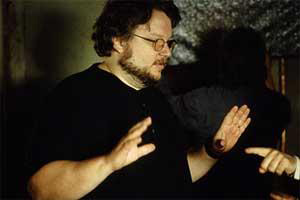 |
 |
 |
 Entertainment | January 2007 Entertainment | January 2007  
Dark Fantasies of a Mexican Auteur
 Bruce Newman - Mercury News Bruce Newman - Mercury News


| Guillermo del Toro directs "Pan's Labyrinth."
(Picturehouse) |
Despite his standing as one of the leading directors of Mexican cinema's New Wave, Guillermo del Toro was accustomed to having the titles of his Spanish-language movies translated for English-speaking audiences: "El Espinazo del Diablo" became "The Devil's Backbone" in 2001, and "La Invención de Cronos" - his 1993 breakthrough film - became, well, OK, "Cronos." But without that fancy rolling R.

Del Toro's current film is about a life-changing encounter between a magical - but menacing - faun and a little girl, so he expected "El Labertino del Fauno" to be titled "The Faun's Labyrinth" when it opens here Friday. But it isn't. For reasons that remain unclear to del Toro, the movie is now called "Pan's Labyrinth," even though the faun in the film is never referred to as Pan. And the character's creator says he isn't Pan.

"Maybe `The Faun's Labyrinth' sounds like a Henry Winkler movie," del Toro says with a puzzled shrug.

The Fonz is nowhere to be found in "Pan's Labyrinth," and there are very few happy days at the military outpost commanded by the fascist Capt. Vidal (Sergi Lopez), where resistance fighters seek to overturn the outcome of the Spanish Civil War five years after it formally ended in 1939.

"It's a very interesting war for me because people I knew when I was growing up in Mexico were refugees from there," says del Toro, who shot the film in Spain with a crew that was half local and half Mexican. "I think it's a war that has been romanticized by `For Whom the Bell Tolls,' but it was one of the most brutal wars ever. So it's a morbidly fascinating subject, and for a Mexican, extremely close to home."

What makes "Pan's Labyrinth" so unusual is that its story is told through the eyes of a young girl named Ofelia (Ivana Baquero), who encounters a giant faun in the woods, leading to a series of adventures that roughly parallel the grim reality of her experiences with Vidal, who has become her stepfather and gotten Ofelia's mother pregnant. Superficially, at least, Ofelia's first meeting with the faun resembles Lucy's encounter with Mr. Tumnus in "The Chronicles of Narnia: The Lion, the Witch and the Wardrobe."

" `Narnia' comes from a much older archetype," del Toro says. "Mr. Tumnus in the Narnia chronicles is a sort of inoffensive boy, but the faun here is a hefty creature of the woods. We can share elements with all fairy tales, but this one is grimier, nastier and somewhat crazier than the others."

Del Toro felt the filmed adaptations of classic fairy tales from literature "tended to dwell only on the Disney-esque aspects" of the stories. "When you read Hansel and Gretel, you realize that these are children starving, being abandoned in the woods to be eaten by beasts," del Toro says, "and out of this absolutely grim environment comes the gingerbread house. If you just do the gingerbread house, then you're Disneyfying the tale. Cinderella is about the exploitation of child labor, Dickens is a horrible situation for kids, and Hans Christian Andersen is tales of S&M mutilation. So I felt that that component, which is incredibly sad and powerful, was missing from fairy tale movies."

To make sure it wasn't missing from his movie, del Toro has made the violence so realistic and brutal that "Pan's Labyrinth" has received an R from the ratings board. "This is a hard R-rated movie," he says. "I've done my share of balletic violence, but I don't think you should soft-pedal war. Especially not now."

The faun's mortal counterpart is the villainous Vidal, and del Toro specifically wrote the part for Lopez, probably best known to American audiences as the amoral hotel manager in "Dirty Pretty Things" and the title character in Dominik Moll's French thriller "With a Friend Like Harry."

But Lopez had another commitment, which gave del Toro only a short time to finish writing the script. "Then a big, big name actor became available, and it looked like Sergi would fall out," del Toro recalls. "But I said, `No, I want this guy.' "

Vidal has spent his entire life attempting to live up to his father's reputation for bravery, but he channels his inadequacies into violence. "Fascism is a paternal concern, a masculine concern, so I needed to create a character who appears to the outside world to be very secure in himself, very attractive, very strong, but when he's alone he hates himself," del Toro says. "His only project is to raise his son to be in awe of him. It's at the same time a very fragile character and a very strong character."

Del Toro demonstrated his deft touch with the title character in "Hellboy," which he directed in 2004, and for which he is preparing the sequel, "Hellboy 2: The Golden Army." And he began his exploration of the Spanish Civil War in "The Devil's Backbone," in which a 10-year-old boy in an orphanage encounters a ghost.

"I love writers and artists who are concerned with the pagan as a form of knowing the subconscious," del Toro says. "I've circled this theme all my life, with `Cronos' with `Devil's Backbone.' And I felt that it was finally a time to be brave and try it, you know?"

`Pan's Labyrinth'Opens Friday

Rated R (graphic violence, some profanity)

Cast Sergi Lopez, Maribel Verdu, Ivana Baquero

Writer-director Guillermo del Toro

Running time 1 hour, 52 minutes

Contact Bruce Newman at bnewman@mercurynews.com or (408) 920-5004. Read his blog at www.mercextra.com /bnewman | 
 | |
 |



